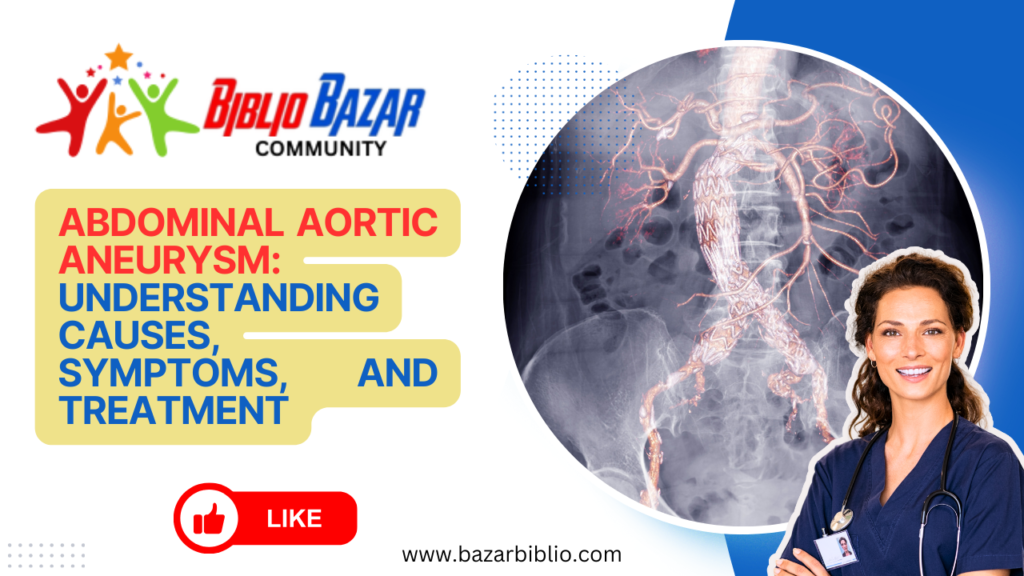
An abdominal aortic aneurysm (AAA) is a serious condition characterized by the enlargement of the abdominal aorta, the major artery that supplies blood to the lower half of the body. This enlargement occurs when a section of the artery wall weakens and balloons outward, which can lead to a life-threatening rupture if not addressed promptly.
Types and Causes of Abdominal Aortic Aneurysms
There are several types of AAAs, including fusiform aneurysms, which are symmetrical and involve the entire circumference of the aorta, and saccular aneurysms, which are asymmetrical and localized to one side of the artery wall. The primary cause of an AAA is atherosclerosis, the buildup of fatty deposits on the artery walls. Other contributing factors include genetic predisposition, high blood pressure, smoking, and age, with most cases occurring in individuals over 60. Men are more frequently affected than women.

Risk Factors and Symptoms
Risk factors for AAA include a family history of the condition, hyperlipidemia, cardiovascular disease, and certain connective tissue disorders such as Marfan syndrome. Symptoms of an AAA can vary widely. Small AAAs often produce no symptoms and are discovered incidentally during imaging studies for other conditions. Larger aneurysms may cause a pulsating feeling near the navel, deep and constant pain in the abdomen or side, or back pain. A ruptured aneurysm can cause sudden, severe pain, hypotension, and shock, which constitutes a medical emergency.
Treatment Options and Surgical Management
Treatment options for AAA depend on the size and growth rate of the aneurysm, as well as the overall health of the patient. Small, asymptomatic aneurysms may be monitored with regular ultrasound or CT scans to track their size. Lifestyle modifications, such as quitting smoking and controlling blood pressure, are recommended to reduce the risk of growth and rupture.

Larger or symptomatic aneurysms typically require surgical intervention. The two main surgical options are open abdominal surgery and endovascular aneurysm repair (EVAR). Open surgery involves replacing the damaged section of the aorta with a synthetic graft, while EVAR is a minimally invasive procedure where a stent graft is placed inside the aneurysm via catheters inserted through the arteries.
Open surgery is more invasive but has a long track record of effectiveness, whereas EVAR is less invasive, with quicker recovery times but may require more frequent follow-ups and potential reinterventions.

Nursing Care Plan
Nursing care for patients with an AAA involves preoperative and postoperative management. Preoperative care includes patient education about the procedure, management of hypertension and other comorbidities, and smoking cessation support. Postoperative care focuses on monitoring for complications such as bleeding, infection, and graft occlusion. Pain management, wound care, and ensuring adequate hydration and nutrition are also crucial. Nurses play a key role in patient education, emphasizing the importance of follow-up appointments and lifestyle changes to prevent recurrence or complications.
Frequently Asked Questions
- What is an abdominal aortic aneurysm?
An abdominal aortic aneurysm is an enlargement of the abdominal aorta due to a weakened artery wall, which can lead to a potentially fatal rupture. - What causes an abdominal aortic aneurysm?
The primary cause is atherosclerosis, but genetic factors, high blood pressure, smoking, and age are also significant contributors. - What are the symptoms of an abdominal aortic aneurysm?
Small AAAs may have no symptoms, while larger ones can cause a pulsating sensation near the navel, abdominal or back pain, and in severe cases, sudden severe pain and shock from a rupture. - How is an abdominal aortic aneurysm diagnosed?
AAAs are often discovered incidentally during imaging studies for other conditions, but ultrasounds and CT scans are commonly used for diagnosis. - What are the treatment options for an abdominal aortic aneurysm?
Treatment depends on the size and symptoms. Small aneurysms are monitored, while larger ones may require surgery, either open abdominal surgery or endovascular aneurysm repair (EVAR). - What is the difference between open surgery and EVAR?
Open surgery involves a more invasive procedure to replace the damaged section of the aorta, while EVAR is a less invasive procedure using a stent graft placed via catheters. - What are the risks of surgery for an abdominal aortic aneurysm?
Risks include bleeding, infection, graft occlusion, and complications related to anesthesia. EVAR may also require more frequent follow-ups. - How can I prevent an abdominal aortic aneurysm?
Preventive measures include quitting smoking, controlling blood pressure, maintaining a healthy diet, and regular check-ups, especially if you have risk factors. - What is the prognosis for someone with an abdominal aortic aneurysm?
The prognosis depends on the size and treatment of the aneurysm. Regular monitoring and timely surgical intervention can improve outcomes significantly. - What is the role of nurses in managing abdominal aortic aneurysms?
Nurses provide essential preoperative and postoperative care, including patient education, monitoring for complications, pain management, and supporting lifestyle changes to prevent recurrence.
subscribe us for more videos like this and visit bazarbiblio.com for notes and free pdf books Thank You.
Discover more from Bibliobazar Digi Books
Subscribe to get the latest posts sent to your email.


